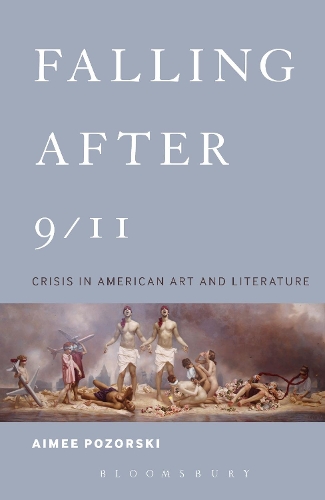
Falling After 9/11: Crisis in American Art and Literature
(Hardback)
Available Formats
Publishing Details
Falling After 9/11: Crisis in American Art and Literature
By (Author) Dr. Aimee Pozorski
Bloomsbury Publishing PLC
Bloomsbury Academic USA
18th December 2014
United States
Classifications
Professional and Scholarly
Non Fiction
History of art
810.9006
Physical Properties
Hardback
176
Width 140mm, Height 216mm
354g
Description
Falling After 9/11 investigates the connections between violence, trauma, and aesthetics by exploring post 9/11 figures of falling in art and literature. From the perspective of trauma theory, Aimee Pozorski provides close readings of figures of falling in such exemplary American texts as Don DeLillo's novel, Falling Man, Diane Seuss's poem, "Falling Man," Jonathan Safran Foer's Extremely Loud and Incredibly Close, Frdric Briegbeder's Windows on the World, and Richard Drew's famous photograph of the man falling from the World Trade Center. Falling After 9/11 argues that the apparent failure of these texts to register fully the trauma of the day in fact points to a larger problem in the national tradition: the problem of referenceof how to refer to fallingin the 21st century and beyond.
Reviews
In this tightly focused study, Aimee Pozorski draws out the links between trauma, aesthetics and memory, and tracks how the censored image of the falling man continues to haunt the American imagination. -- Michael Kalisch * Times Literary Supplement *
Aimee Pozorski takes post-9/11 literary scholarship to the next level. This erudite and thoughtful book addresses the crisis in literary and artistic representation in the wake of the 2001 terrorist attacks. Pozorski moves beyond the notion of language, literature and art as delimiting the apprehension of the traumatic event to make the case that we are simply unable to read signs within our culture. Drawing together key theoretical ideas and critical analyses to offer a series of shrewd textual readings, Pozorski offers fresh and inventive insights. Falling After 9/11 is a substantial scholarly achievement. * Catherine Morley, Senior Lecturer in American Literature, University of Leicester, UK *
Pozorskis attentive investigation of the 9/11 falling man in art and literature reinvigorates our thinking about violence, trauma, and aesthetics. Challenging the conventional wisdom about traumas resistance to representation, Pozorski daringly asserts that the inescapably literal presence of the falling man produces the opposite effect: an overwhelming abundance of representational possibility. * Mitchum Huehls, Associate Adjunct Professor of English, University of California, Los Angeles, USA, and author of Qualified Hope: A Postmodern Politics of Time *
In these illuminating and diverse analyses, Aimee Pozorski breaks new ground for trauma studies and its place in the twenty-first century. Richly argued and lyrical in its readings of the horrific beauty of the figure of the falling man, her book shows how trauma in the post 9/11 era is uniquely characterized by the excessive potential for reference rather than by inherent limitations to reference. Falling After 9/11 offers a telling critique of how the falling man can become, through the power of language and narrative, a figure who falls up, as it were, into alternative futures in which coming to terms with the terror of real events becomes a genuine possibility. * Jennifer Yusin, Associate Professor English, Drexel University, USA *
A timely book about the phenomenon of collective mourning in the 21st century, Falling After 9/11 illuminates the complex dynamic between the national clamor to 'never forget' and the ubiquitous mistrust of the artistic forms to which we attempt to commit that memory. Pozorski offers a lucid and engaging account of a moment of crisis in American literature that deftly speaks to fundamental theoretical questions about how we read the world around us. * Sarah Senk, Assistant Professor of English, University of Hartford, USA *
Falling After 9/11 does an excellent job of corralling various literary representations of the falling man, and of thinking through what these representations might imply about the broader state of US art. [Pozorskis] decision to focus on the figure of the falling man is an ingenious one, and it is her sustained examination of this recurring trope that gives the book its momentum. Pozorskis readings are nuanced and incisive, and she makes a persuasive argument on the moral and artistic complexities associated with post-9/11 art. Her account of the recurring presence of the falling man in a diverse range of texts will strongly inform future studies In emphatically answering the provocative questions posed by a range of post-9/11 artworksincluding Mouly and Spiegelmans iconic New Yorker cover artPozorksi reveals the many ways in which trauma can be meaningfully represented, and in doing so expands our understanding of the tragedy of 9/11 itself. * U.S. Studies Online, British Association for American Studies (reviewed by Lucas Thompson, University of Sydney, Australia) *
Pozorski examines the figure of the falling man in 9/11 literature and the arts, and its representation within the theoretical framework of trauma Pozorski is at her best when she shows how, as she writes in the introduction, critics in the contemporary art and literary worlds demand representations of 9/11 fraught with jarring images. The author successfully highlights the contradictory behaviors of critics and the general public. On the one hand, they demand that artists address the big questions and problems of the times. On the other hand, they have a tendency to dismiss such works, often judging them inappropriate, inadequate, untimely, disrespectful, opportunist, too clean, or too violent. The epiloguea detailed analysis of Parrishs mural painting The Cycle of Terror and Tragedy (depicted on the book's cover)is absolutely brilliant in providing new ways of thinking about and interpreting the representations of 9/11 in art and literature. Summing Up: Highly recommended. Graduate students, researchers, faculty. -- A.-P. Durand, University of Arizona * CHOICE *
Author Bio
Aimee Pozorski is Professor of English at Central Connecticut State University, USA, where she teaches contemporary literature and trauma theory. She is the current President of The Philip Roth Society.
